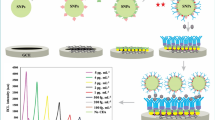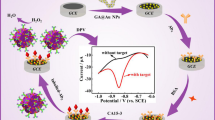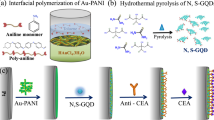Abstract
An innovative and ultrasensitive electrochemical impedimetric immunosensor was developed for the quantitative detection towards carcinoembryonic antigen (CEA). CEA is a widely utilized tumour biomarker that is generated in a wide variety of cancers and it is a frequently used biomarker for clinical research and early detection of cancer. Novelty of the present work is the utilization of biomimetic membrane comprising gold nanoparticle–stabilized lipid bilayer (SLB) containing DOPE (1,2-dioleoyl-sn-glycero-3-phosphoethanolamine) and DOTAP (N-[1-(2,3-Dioleoyloxy)propyl]-N,N,N-trimethyl ammonium Propane) for easy protein insertion, bio-affinity, and bio-functionalization towards the detection of CEA. The SLB is tethered on stable tungsten disulfide decorated MWCNT (WS2@MWCNT) surface for the sensitive and selective detection of CEA. The WS2@MWCNT surface has been chosen to tether SLB due to its numerous unique characteristics such as greater surface area, high conductivity, and excellent electronic conductivity, which in turn leads to the improvement of the superior electrochemical sensing ability towards CEA. The lone SLB when used for protein insertion lacks space and impedes the functional incorporation of transmembrane proteins with hydrophilic domains on both sides and biosensing applications. The SLB-tethered WS2@MWCNT surface (SLB-WS2@MWCNT) was examined by studying the electrochemical changes in the existence of redox probe K3/K4 [Fe(CN)6] through cyclic voltammetry (CV) and electrochemical impedance spectroscopy (EIS). The combined excellent properties of WS2@MWCNT and SLB have shown to amplify the sensitive detection of CEA with a LOD value of 0.2 pg mL−1. The developed sensor provides higher stability, sensitivity, and excellent reproducibility towards the detection of CEA with relative standard deviation (RSD) of < 5%. The encouraging results demonstrate that the CEA impedimetric immunosensor has potential in practical analysis and lays a solid platform for additional biomarker detection in early clinical diagnosis.
Graphical Abstract







Similar content being viewed by others
References
Adam JK, Odhav B, Bhoola KD (2003) Immune responses in cancer. Pharmacol Ther 99(1):113–132
Yang Y, Liu Q, Liu Y, Cui J, Liu H, Wang P, ... and Dong Y (2017) A novel label-free electrochemical immunosensor based on functionalized nitrogen-doped graphene quantum dots for carcinoembryonic antigen detection. Biosens Bioelectron 90:31–38
Zhang C, Zhang S, Jia Y, Li Y, Wang P, Liu Q, ... and Dong Y (2019) Sandwich-type electrochemical immunosensor for sensitive detection of CEA based on the enhanced effects of Ag NPs@ CS spaced Hemin/rGO. Biosens Bioelectron 126:785–791
Su S, Sun Q, Wan L, Gu X, Zhu D, Zhou Y, ... and Wang L (2019) Ultrasensitive analysis of carcinoembryonic antigen based on MoS2-based electrochemical immunosensor with triple signal amplification. Biosens Bioelectron 140:111353
Yan J, Hu M, Li D, He Y, Zhao R, Jiang X, ... and Fan C (2008) A nano-and micro-integrated protein chip based on quantum dot probes and a microfluidic network. Nano Res 1(6):490–496
Prabhulkar S, Alwarappan S, Liu G, Li CZ (2009) Amperometric micro-immunosensor for the detection of tumor biomarker. Biosens Bioelectron 24(12):3524–3530
Fan C, Zhuang Y, Li G, Zhu J, Zhu D (2000) Direct electrochemistry and enhanced catalytic activity for hemoglobin in a sodium montmorillonite film. Electroan: Int J Dev Fund Prac Electroan 12(14):1156–1158
Ge Z, Pei H, Wang L, Song S, Fan C (2011) Electrochemical single nucleotide polymorphisms genotyping on surface immobilized three-dimensional branched DNA nanostructure. Sci China Chem 54(8):1273–1276
Nourani S, Ghourchian H, Boutorabi SM (2013) Magnetic nanoparticle-based immunosensor for electrochemical detection of hepatitis B surface antigen. Anal Biochem 441(1):1–7
Lim SA, Yoshikawa H, Tamiya E, Yasin HM, Ahmed MU (2014) A highly sensitive gold nanoparticle bioprobe based electrochemical immunosensor using screen printed graphene biochip. RSC Adv 4(102):58460–58466
Rizwan M, Elma S, Lim SA, Ahmed MU (2018) AuNPs/CNOs/SWCNTs/chitosan-nanocomposite modified electrochemical sensor for the label-free detection of carcinoembryonic antigen. Biosens Bioelectron 107:211–217
Pina TC, Zapata IT, Hernández FC, López JB, Paricio PP, Hernández PM (2001) Tumour markers in serum, bronchoalveolar lavage and biopsy cytosol in lung carcinoma: what environment lends the optimum diagnostic yield? Clin Chim Acta 305(1–2):27–34
Yuan J, Wang G, Majima K, Matsumoto K (2001) Synthesis of a terbium fluorescent chelate and its application to time-resolved fluoroimmunoassay. Anal Chem 73(8):1869–1876
Li R, Feng F, Chen ZZ, Bai YF, Guo FF, Wu FY, Zhou G (2015) Sensitive detection of carcinoembryonic antigen using surface plasmon resonance biosensor with gold nanoparticles signal amplification. Talanta 140:143–149
Zhao Y, Liu L, Kong D, Kuang H, Wang L, Xu C (2014) Dual amplified electrochemical immunosensor for highly sensitive detection of Pantoea stewartii sbusp. stewartii. ACS Appl Mater Interf 6(23):21178–21183
Ma E, Wang P, Yang Q, Yu H, Pei F, Li Y, ... and Dong Y (2019) Electrochemical immunosensor based on MoS2 NFs/Au@ AgPt YNCs as signal amplification label for sensitive detection of CEA. Biosens Bioelectron 142:111580
Liang H, Luo Y, Li Y, Song Y, Wang L (2022) An immunosensor using electroactive COF as signal probe for electrochemical detection of carcinoembryonic antigen. Anal Chem 94(13):5352–5358
Ranjan P, Yadav S, Sadique MA, Khan, R, Srivastava AK (2022) Ionic Liquid-Functionalized ZrO2/Reduced Graphene Oxide Nanocomposites for Carcinoembryonic Antigen Electrochemical Detection. ACS Appl. Nano Mater 5(10):14999–15010
Chen M, Li Y, Han R, Chen Q, Jiang L, Luo X (2022) Click reaction-assisted construction of antifouling immunosensors for electrochemical detection of cancer biomarkers in human serum. Sens Actuators, B Chem 363:131810
Divya KP, Grace AA, Dharuman V (2019) Rapid and sensitive electrochemical label free ion channel, membrane protein and DNA sensing on surface supported liposome-gold nanoparticle platform. J Electroanal Chem 834:56–63
Bhuvana M, Narayanan JS, Dharuman V, Teng W, Hahn JH, Jayakumar K (2013) Gold surface supported spherical liposome–gold nano-particle nano-composite for label free DNA sensing. Biosens Bioelectron 41:802–808
Divya KP, Dharuman V (2017) Supported binary liposome vesicle-gold nanoparticle for enhanced label free DNA and protein sensing. Biosens Bioelectron 95:168–173
Martín-Yerga D, González-García MB, Costa-García A (2014) Electrochemical immunosensor for anti-tissue transglutaminase antibodies based on the in situ detection of quantum dots. Talanta 130:598–602
Ansari AA, Kaushik A, Solanki PR, Malhotra BD (2008) Sol–gel derived nanoporous cerium oxide film for application to cholesterol biosensor. Electrochem Commun 10(9):1246–1249
Han J, Zhuo Y, Chai Y, Yu Y, Liao N, Yuan R (2013) Electrochemical immunoassay for thyroxine detection using cascade catalysis as signal amplified enhancer and multi-functionalized magnetic graphene sphere as signal tag. Anal Chim Acta 790:24–30
Divya KP, Karthikeyan R, Sinduja B, Grace AA, John SA, Hahn JH, Dharuman V (2019) Carbon dots stabilized silver–lipid nano hybrids for sensitive label free DNA detection. Biosens Bioelectron 133:48–54
Tang J, Tang D, Su B, Huang J, Qiu B, Chen G (2011) Enzyme-free electrochemical immunoassay with catalytic reduction of p-nitrophenol and recycling of p-aminophenol using gold nanoparticles-coated carbon nanotubes as nanocatalysts. Biosens Bioelectron 26(7):3219–3226
Vaziri HS, Shokuhfar A, Afghahi SSS (2020) Synthesis of WS2/CNT hybrid nanoparticles for fabrication of hybrid aluminum matrix nanocomposite. Mater Res Exp 7(2):025034
Keerthana S, Rajapriya A, Viswanathan C, Ponpandian N (2021) Enzyme like-colorimetric sensing of H2O2 based on intrinsic peroxidase mimic activity of WS2 nanosheets anchored reduced graphene oxide. J Alloy Compd 889:161669
Wang Y, Kong D, Shi W, Liu B, Sim GJ, Ge Q, Yang HY (2016) Ice templated free-standing hierarchically WS2/CNT-rGO aerogel for high-performance rechargeable lithium and sodium ion batteries. Adv Energy Mater 6(21):1601057
Keerthana S, Rajapriya A, Amirthapandian S, Viswanathan C, Ponpandian N (2021) WS2 hierarchical nanoflowers on rGO with enhanced electrochemical performance for sensitive and selective detection of mesalazine in real sample analysis. Colloids Surf, A 618:126452
Keerthana S, Rajapriya A, Viswanathan C, Ponpandian N (2022) Hybrid nanostructures of WS2 nanoflowers on N, B co-doped rGO for sensitive amperometric detection of Nilutamide. Mater Today Chem 26:101052
Kumar S, Lei Y, Alshareef NH, Quevedo-Lopez MA, Salama KN (2018) Biofunctionalized two-dimensional Ti3C2 MXenes for ultrasensitive detection of cancer biomarker. Biosens Bioelectron 121:243–249
Liu J, Wang J, Wang T, Li D, Xi F, Wang J, Wang E (2015) Three-dimensional electrochemical immunosensor for sensitive detection of carcinoembryonic antigen based on monolithic and macroporous graphene foam. Biosens Bioelectron 65:281–286
Gu X, She Z, Ma T, Tian S, Kraatz HB (2018) Electrochemical detection of carcinoembryonic antigen. Biosens Bioelectron 102:610–616
Song D, Zheng J, Myung NV, Xu J, Zhang M (2021) Sandwich-type electrochemical immunosensor for CEA detection using magnetic hollow Ni/C@ SiO2 nanomatrix and boronic acid functionalized CPS@ PANI@ Au probe. Talanta 225:122006
Cao L, Xiao H, Fang C, Zhao F, Chen Z (2020) Electrochemical immunosensor based on binary nanoparticles decorated rGO-TEPA as magnetic capture and Au@ PtNPs as probe for CEA detection. Microchim Acta 187(10):1–10
Xue S, Yi H, Jing P, Xu W (2015) Dendritic Pt@ Au nanowires as nanocarriers and signal enhancers for sensitive electrochemical detection of carcinoembryonic antigen. RSC Adv 5(94):77454–77459
Ma S, Zhang Q, Qin M, Wang H, Zhu Y, Zhang Y, Zhang K (2021) A sensing interface based on 3D CS-Au NPs/hPPy for electrochemical detection of carcinoembryonic antigen. Int J Electrochem Sci 16(4):210437
Acknowledgements
The authors sincerely thank DST-FIST, UGC-SAP, and DST-PURSE, Government of India, for their necessary instrumental facilities accessible in their department.
Funding
Dr. N. Ponpandian and SK received grants from UGC-DAE CSR (CSR-KN/CRS- 111/2018–19/1050), Indore and Kalpakkam Node through collaborative research project. KPD, AR, and NP received grants from Rashtriya Uchattar Shiksha Abhiyan (RUSA-BCTRC), Bharathiar University, Coimbatore 641 046, India.
Author information
Authors and Affiliations
Corresponding author
Ethics declarations
Conflict of interest
The authors declare no competing interests.
Additional information
Publisher's note
Springer Nature remains neutral with regard to jurisdictional claims in published maps and institutional affiliations.
Supplementary Information
Below is the link to the electronic supplementary material.
Rights and permissions
Springer Nature or its licensor (e.g. a society or other partner) holds exclusive rights to this article under a publishing agreement with the author(s) or other rightsholder(s); author self-archiving of the accepted manuscript version of this article is solely governed by the terms of such publishing agreement and applicable law.
About this article
Cite this article
Keerthana, S., Divya, K.P., Rajapriya, A. et al. Electrochemical impedimetric immunosensor based on stabilized lipid bilayer–tethered WS2@MWCNT for the sensitive detection of carcinoembryonic antigen. Microchim Acta 189, 450 (2022). https://doi.org/10.1007/s00604-022-05557-2
Received:
Accepted:
Published:
DOI: https://doi.org/10.1007/s00604-022-05557-2




